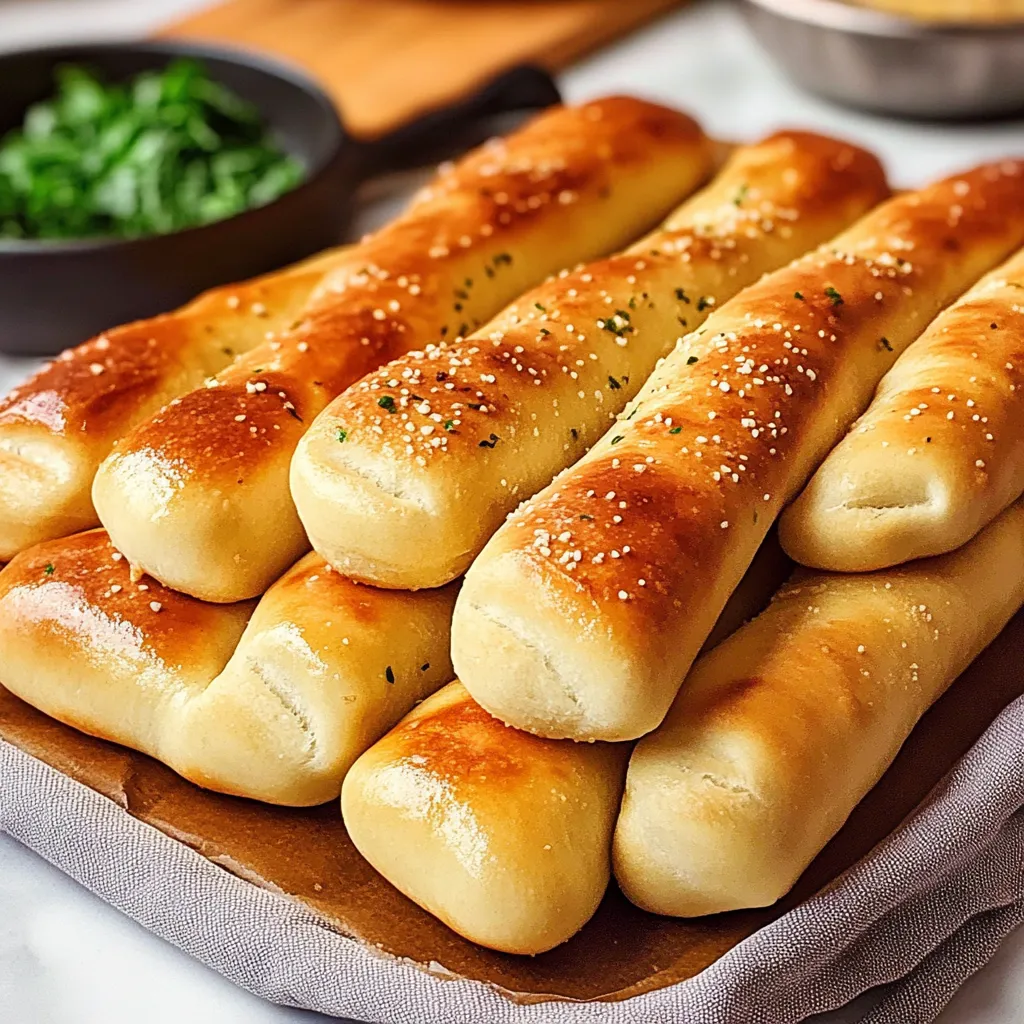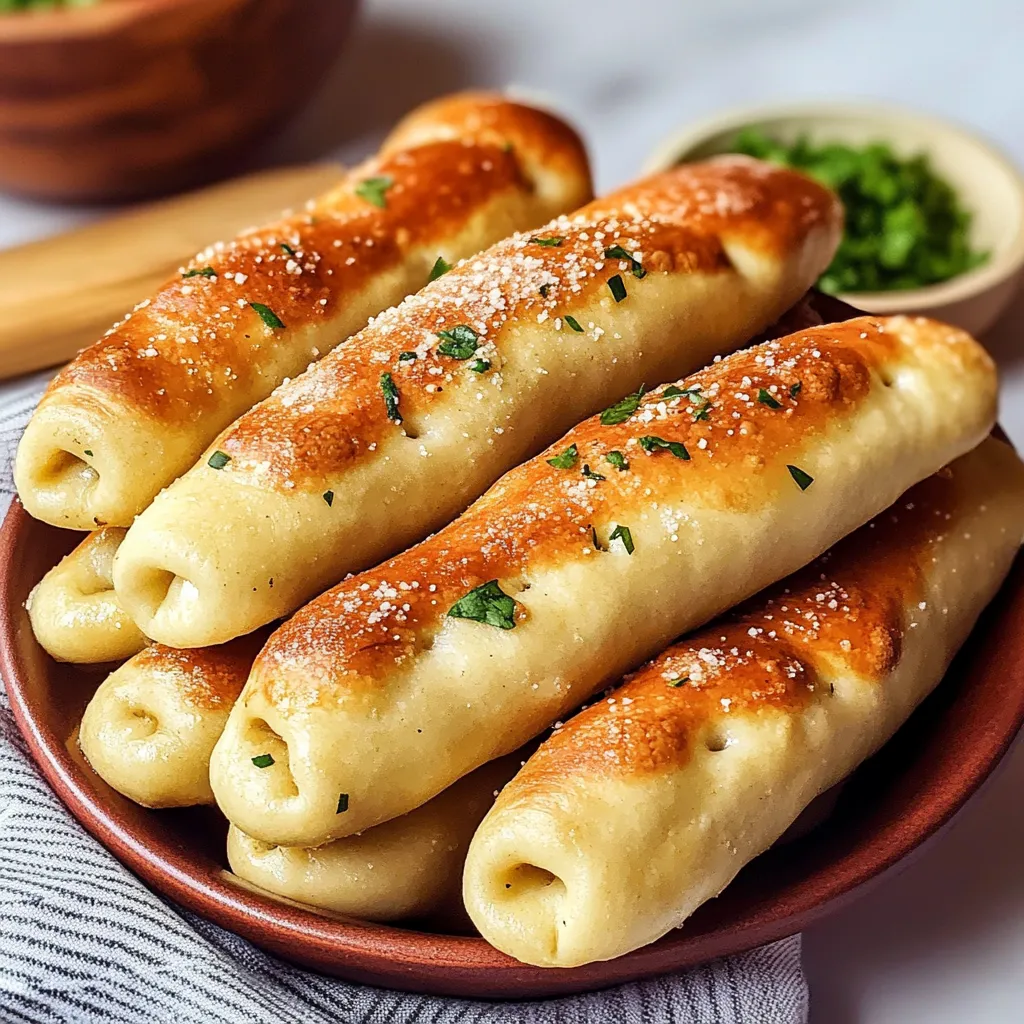 Pin
Pin
This Copycat Olive Garden Breadsticks recipe brings the magic of those warm, buttery restaurant favorites right to your kitchen. After years of trial and error, I've finally perfected a homemade version that captures that irresistible chew and garlic butter topping that makes the original so addictive.
The first time I made these breadsticks for Sunday dinner, my family literally fought over the last one. Now they're requested for practically every gathering, and I always make a double batch.
Ingredients
- Warm water: About 100-110°F is the sweet spot that activates yeast without killing it. I always use a thermometer for precision.
- Instant yeast: Provides reliable rise without proofing first in liquid.
- Granulated sugar: Feeds the yeast and adds subtle sweetness to balance the salt.
- Unsalted butter: Creates tenderness in the dough and richness in flavor.
- Salt: Enhances all the flavors and strengthens the gluten structure.
- Bread flour: The higher protein content creates that signature chew. Use all-purpose if needed, but bread flour gives the authentic texture.
- Kosher salt for topping: The coarser grains add that perfect salty finish.
- Garlic powder: Provides that signature Olive Garden flavor without burning like fresh garlic.
Step-by-Step Instructions
- Prepare the baking sheets:
- Line two sheets with parchment paper for easy removal and to prevent sticking. The parchment also helps insulate the bottom of the breadsticks so they don't over-brown.
- Mix the dough:
- Combine water, yeast, sugar, melted butter, and salt in your stand mixer bowl. The liquid temperature is crucial here. Too hot will kill the yeast, too cool will slow activation. Gradually add the flour while mixing on low speed to prevent flour clouds, then increase to medium for proper gluten development.
- Knead thoroughly:
- Spend the full 10-15 minutes kneading until the dough becomes very elastic. You should be able to stretch a small piece thin enough to see light through it without tearing. This windowpane test ensures proper gluten development for that signature chew.
- First rise:
- Place dough in an oiled bowl, cover, and let rise until doubled. This slow fermentation develops flavor. I like to mark the side of my bowl with a rubber band to easily see when it's doubled.
- Shape the breadsticks:
- Divide dough into precisely 57-gram portions for consistency. Roll each into an 8-inch log using both hands, starting from the center and working outward with gentle pressure. The rolling technique is crucial for that perfect cylindrical shape.
- Second rise:
- Allow breadsticks to double in size again on the baking sheets. They should look puffy and when gently poked, the indentation should slowly fill back in but not completely disappear.
- Bake to golden perfection:
- Watch carefully during the last few minutes as they can quickly go from perfect to overdone. You want an even golden color across the top.
- Apply butter topping:
- Brush immediately while hot so the breadsticks absorb the butter. The garlic salt mixture should be sprinkled while the butter is still wet so it adheres properly.
 Pin
Pin
My family's favorite moment with these breadsticks was when my daughter declared them better than the restaurant version during a blind taste test we held for fun. I think the secret is using high quality butter and being generous with that final brushing.
Make-Ahead Options
These breadsticks work beautifully as a make-ahead option. You can prepare the dough through the first rise, then shape the breadsticks and refrigerate overnight. The next day, simply let them come to room temperature for about 30 minutes, then proceed with the final rise and baking. This slow fermentation actually enhances the flavor, making them even better than the same-day version.
Troubleshooting Tips
If your breadsticks aren't rising properly, check your yeast freshness and kitchen temperature. For slow rising dough, create a warm environment by placing the covered dough near a preheating oven or on top of a refrigerator. If your breadsticks turn out too dense, you likely added too much flour or didn't knead long enough to develop proper gluten structure.
Perfect Pairings
These breadsticks shine brightest alongside Italian classics. Pair them with lasagna, spaghetti, or any tomato-based pasta dish where they can sop up extra sauce. For an appetizer presentation, serve them standing upright in a tall glass alongside marinara dipping sauce. They also complement soups beautifully, especially minestrone or a creamy tomato bisque.
Recipe Questions & Answers
- → How do I make chewy breadsticks?
Knead the dough until tacky and very elastic, proof properly in a warm environment, and avoid overbaking.
- → Can I freeze these breadsticks?
Yes, freeze after baking. Reheat in a 425°F oven for 4-5 minutes for freshness.
- → What makes these breadsticks taste like Olive Garden?
The buttery garlic topping and chewy texture replicate the signature Olive Garden flavor.
- → Can I use all-purpose flour instead of bread flour?
Yes, but bread flour produces a chewier texture due to its higher protein content.
- → How do I avoid killing the yeast?
Use water heated to 100-110°F. Too hot water can dehydrate and deactivate the yeast.